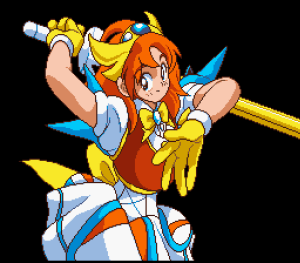 |
|
|---|---|
| Title | Kendo Rage |
| Developer | Affect Co. Ltd. |
| Publisher | Seta U.S.A. |
| Release Date | October 1993 |
| Genre | Action platformer |
| Platform | Super Nintendo |
| Age Rating | All ages |
| No official website available | |
Kendo Rage has been with me since my childhood. I don’t remember exactly how it found its way into my life, but I do remember my experiences. For me, Kendo Rage was one of those games you’d play for awhile and place back on the shelf for an extended period of time before trying again. It wouldn’t be until I was older, and had more gaming skill, that I’d see the ending to one of the most polarizing games of my childhood.
This Super Nintendo title is quite a strange one. Kendo Rage is a wacky tale of a girl trying to get to school on time while having to fight monsters every step of the way. But, the funny thing is, this game’s history is so obscure that in order to really understand what’s going on here we need to take a look at the whole picture. So, students, get out your gaming textbooks and join me for this edition of Throwback Thursday where we review Kendo Rage, or more accurately, Makeruna! Makendou. That being said, class is now officially in session!
Kendo Rage is an action platformer developed by Affect Co. Ltd. The official title of this game is Makeruna! Makendou, which closely translated is, “Don’t lose! Magic Kendo.” It was released on January 22nd, 1993 in Japan and the following October in North America under the name Kendo Rage. Not only did the title undergo localization changes, but many elements of the story was also changed. But, let’s start at the beginning with a quick history lesson before we review Kendo Rage, so we can keep things simple!
We’ll start with Makeruna! Makendou! Before Seta USA’s localization team had a field day with this game, Datam Polystar published this game to tell a comedic story about spirit detectives, yokai, and magical girls. In Makendou, our main character is Mai Tsurugino. She is a karate prodigy and kendo fanatic. Her spirit level is so high she can see yokai, so a spirit detective named Doro-san enlists her help to stop the yokai problem by hunting them down before they become too big of a problem for human society.
The levels of Makendou are exactly the same as Kendo Rage‘s. I played through both releases just to make sure nothing was censored and to see if any type of design choice was stripped for North America. The only thing that is changed is the names of characters and certain plot points. Since the gameplay and actual levels are basically the same, I’ll go over this game more in the actual review of Kendo Rage. But what else does this series have to offer?

Two years later in 1995, Datam Polystar collaborated with Oriental Light and Magic, now OLM Incorporated, to produce a one episode OVA aptly titled, “Makeruna! Makendou.” OLM inc. has produced a lot of recognizable anime such as Pokemon, Steel Angel Kurumi, Comic Party, and Gunsmith Cats. This OVA centers the story around Mai, Doro-san, and Mai’s sister Hikari, as they battle evil yokai working with an antagonist named Dr. Mud.
The one shot OVA is pretty funny but is still just incredibly average. It has some dirty jokes and mild nudity. You’ll see Mai’s breasts in just a few scenes, but otherwise, it just has perverted undertones. Finding a physical copy of this OVA is incredibly hard, and it was never released outside of Japan. The internet has copies of this anime fansubbed if you look hard enough. But, just like Seta USA’s edits, the translations are off, which leads to more confusion of the series! The kicker is at the end of the episode when Datam Polystar promotes Makeruna! Makendou 2!

What do you think Makeruna! Makendou 2 is exactly? As strange as this series already is, you’d obviously guess that they’d make the direct sequel a fighting game!
Yes, it’s a 2D fighting game. The game is officially named Makeruna! Makendou 2: Kimero Youkai Souri, roughly translated to “Don’t Lose! Magic Kendo 2: Do it! Yokai Prime Minister.” It was released for Super Famicom on March 17th, 1995, followed by a PlayStation release on November 10th, 1995. It has beautiful artwork but plays just average. It’s not the worst fighting game ever, but definitely not the best either. You’ll see this is a running trend with Makendou in general.

Lastly, on March 20th, 1998 a top down RPG titled Makeruna! Makendou Z was developed by Fill-in-Cafe and published by NEC for the NEC PC-FX system. The game looks great from what I’ve seen and has animated cutscenes, but there is too much text for someone like me to translate myself. So, I really can’t comment on the game, but I hope that Makendou finally had its day with an above average game. I’m guessing it didn’t though because the series never carried on after that point.
Since then any detailed history about Makendou has been purged from defunct company websites, and really not much else is known about this series. Now that’s we’ve covered Makendou in detail, what did we get in North America?








